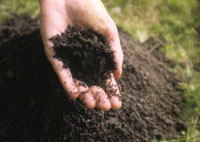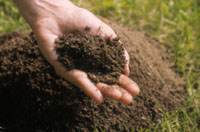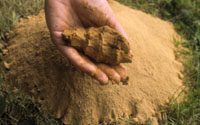





How would you characterize your soil? Is it poor, boggy muck that drains poorly and lacks nutrients? Could it be the red clay of Georgia, the sandy clay of Texas, or the caliche (sandy, rocky, alkaline stuff) of Arizona? You must identify your soil before improving it -- whether it needs fertility, absorbency, or drainability.
See how to determine your soil below.
continue reading below
Loam: The ideal soil holds air, water, and nutrients in a balance of sand, silt, clay, and organic matter. It's easy to work. A handful of loam holds its shape when squeezed, and crumbles when squeezed harder. If well-drained, it leaches nutrients and warms slowly. Add worm castings, rotted manure, and organic matter (compost and chopped leaves) to improve it.

Clay: This heavy, poorly draining stuff forms a sticky, hard mass when squeezed. Plant roots have a hard time growing in clay soil; they may die due to lack of air and water. Improve it with loads of organic matter, such as grass clippings, chopped leaves, old hay, ground bark or wood shavings, and gypsum.

Sand: Sand holds too much air; it holds neither water nor nutrients. A handful crumbles and won't form a ball. It tills easily and warms up quickly. Improve it by adding organic matter: compost, rotted manure, and chopped leaves.
Once you've evaluated your soil, learn how to make your own compost to amend it.
Copyright © www.100flowers.win Botanic Garden All Rights Reserved